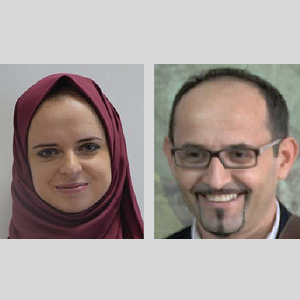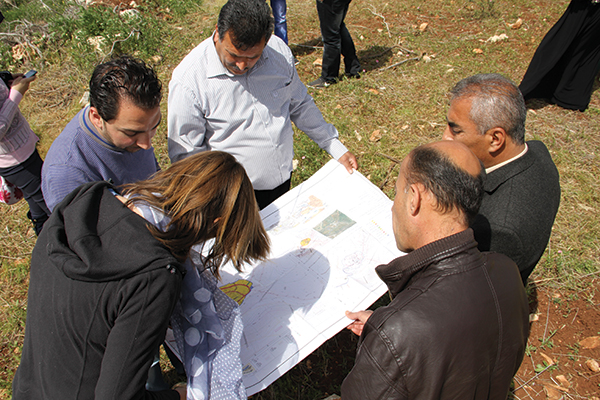
By Asma Ibrahim and Pren Domgjoni
Placemaking
Placemaking is an approach to urban design that intends to ensure the creation of valuable qualities within shared spaces based on a “bottom-to-top approach.” Most of the time, Placemaking is understood merely as an urban design. While it is true that urban design is part of Placemaking, there is more to it: Placemaking is about bringing a community together to decide about the design and use of a public space that can be a street, or a small or large space in the village, town, or the city. Placemaking is not only about large-scale projects and large budgets; in other words, it welcomes increased efforts and collaboration of citizens, professionals, and authorities to design any public place in a way that has meaning.
Placemaking in Area C
During the few past decades, Palestinian communities in Area C have fallen victim to the political situation, since all decision-making in planning was in the hands of the Israeli Civil Administration (ICA). Most Area C villages were considered as an agricultural zone in the Mandatory-era regional plans that the ICA utilized, plans that are inadequate to meet the needs of current populations. Furthermore, the Israeli occupation has enforced a centralized planning system by eliminating community participation. As a result, Palestinians have been left with no other choice than to build without permits – which directly has led to a deterioration of the built environment and has lowered the quality of services, infrastructure, and of shared places. Moreover, Palestinian communities of Area C have come to suffer from a lack of trust in their desire and ability to be a service provider rather than consumer.
Realizing the critical situation of Area C, UN-Habitat salutes Placemaking as a key activity in a program entitled “Planning Support to the Palestinian Communities in Area C” to improve the resilience of the local Palestinian communities. This assistance aims to provide effective planning and coordinated advocacy to Palestinian communities on the one hand, and to enhance Palestinian building capacity on the other hand. Community-design schemes are developed by the Placemaking approach that aims to bridge land-use plans with a better approach to the designing of public places. Thus, UN-Habitat has applied Placemaking to designs in fourteen localities throughout Area C of the West Bank and has implemented them in four out of the fourteen localities, considering Placemaking a tool to quickly and effectively respond to the sensitivity of Area C.
♦ Placemaking projects are tools with the tremendous demonstrative effect to enhance the resilience of marginalized communities in Area C because the process produces realistic and concrete interventions that improve the quality of life. The Placemaking approach utilizes emotional capital, the “belonging to the land,” and local financial capital in places where marginalized people are living on limited resources and spaces. It builds a deep connection between people and their land, since people are encouraged to use and interact with their surroundings, to make them places they truly own.
Building Communities Around Places
The process is designed so each party brings with it its particular strength: the community brings the unique insights and inspirations that come from living in that particular community and caring for it, while the professionals bring technical insights and knowledge of best practice. Through a series of carefully organized workshops, the participants develop a shared understanding of the issues, move to an agreed set of priorities (a design agenda), and eventually arrive at a set of design proposals that are not only realistic and achievable, but also demonstrably respond to the issues that the community agrees are important.
Although Placemaking proposals are as diverse and unique as the communities within which they occur, typically they share a number of features. They
- reconcile local priorities with best practice to ensure that interventions continue to be relevant and appropriate, even when circumstances change or new changes emerge that were not apparent to the community, but are known by the professional experts;
- are designed to meet multiple needs, offering something for everyone;
- require low capital cost and are relatively easy to do and maintain sustainably by the local community, using local skills and materials;
- combine practicality with attractiveness by offering opportunities that people choose to experience, rather than merely solutions that they have no choice than be contented with; and
- leave a positive legacy of empowerment and greater confidence in the performance and legitimacy of the community within which the interventions occur.
Placemaking: Pilot Projects in Four Localities
The Placemaking projects were carried out as a series of workshops at different localities. They were lead by Jenny Donovan, an international expert on urban design, landscaping, and Placemaking, as well as by a specialized and dedicated local team of urban planners and designers, all working hand in hand with local communities. The workshops focused on exploring the local context in order to come up with sustainable Placemaking interventions that can serve present and future generations in the long run. The process took place from March 2014 to January 2015 and was attended by the International Peace and Cooperation Center (IPCC).
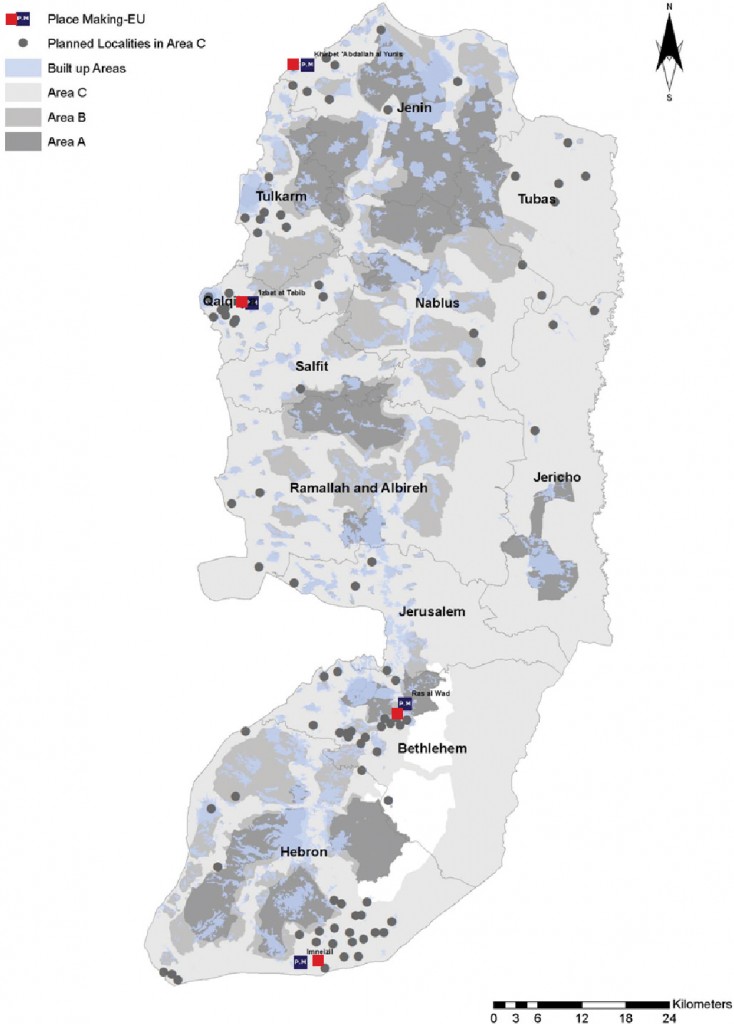
♦ A Placemaking project can be seen as a journey on which the people of a community embark together with external professionals to arrive at a shared plan for key spaces in the community.
In 2014, the final designs were presented in reports that also covered, besides the main Placemaking projects, questions on major infrastructural engineering proposals that can be funded and implemented by other donors. For advocacy and in order to raise awareness, UN-Habitat also organized Training of Trainers (TOT). The TOT-workshop aimed to encourage the new generation of Palestinian planners, urban designers, and civil society activists to apply an inclusive, participatory approach in developing and designing places. In addition, during a public fundraising presentation, donors, NGOs, and Palestinian ministries received information about the results of the Placemaking approach. On this basis, the European Union provided seed funds to implement a demonstration of Placemaking projects in four different localities: Imneizil, Ras Al-Wad, Abdallah Younis, and Izbet Tabib, as shown in Figure (1).
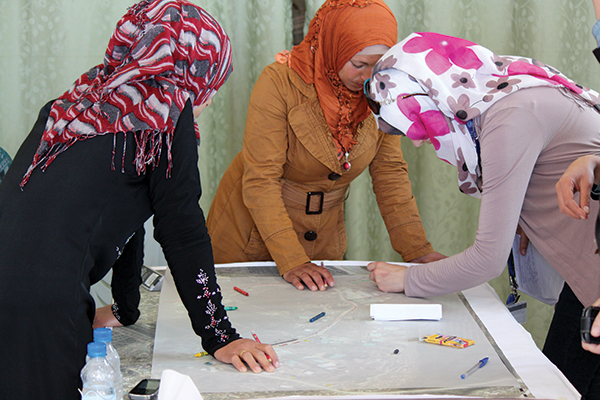
For the implementation of the Placemaking interventions, illustrative drawings of the project were produced in March 2015 that together with the reports provided sufficient details to allow for reasonably accurate estimates of construction costs. Besides, all final designs use local materials and feature simple design concepts in order to reduce operating and managing costs. The final report consisted of the detailed designs, their estimated costs, and the detailed specifications.
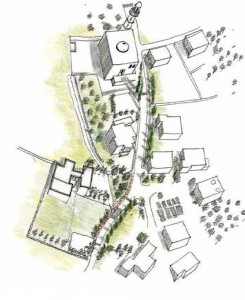
In April 2015, the tendering process started in the four localities and attracted wide interest: out of many applicants, one contractor was selected and the implementation phase was finalized by the end of May 2015. The local council association has been in charge of supervising the work, while UN-Habitat’s role has been to monitor and support it during the implementation phase.
Placemaking in Ras Al-Wad: A Place for Walking,
a Place for Sitting
Ras Al-Wad is a small village near Bethlehem with approximately 500 inhabitants. While it is located partially in Area C, its centre is located in Area B. The Separation Wall separates Ras Al-Wad from the Bethlehem region, and the locality is therefore detached from regional integration. Za’tara offers basic educational and health services for these localities, which makes integration necessary to provide spatial continuity and access to services. Through a planning process, this locality was selected to conduct a Placemaking exercise, and professional designers, planners, local citizens, and authorities designed in three workshops a Placemaking project. Paolo Curradi, the Office of the European Union representative for the West Bank and the Gaza Strip is referring to Placemaking: “Ras Al-Wad is one of the thirty-six villages in Area C in which the European Union is funding an urban planning process, and one of the four villages where we support Placemaking interventions. During the Placemaking process, the entire village is gathering in brainstorming activities to discuss and harvest ideas and images on how to transform the most used public spaces in the village into beautiful and welcoming public places.”
Placemaking focused on the entire village and selected key sites based on the community’s input. The interventions were designed and managed to allow the community to build these sites themselves, wherever possible. This approach supports empowerment and self-determination and cultivates an increased sense of ownership over a community’s surroundings. The interventions:
- improve the environmental and visual quality (landscaping and tree planting);
- calm traffic, which includes accessible and safe pedestrian connections;
- improve access to economic opportunities; and
- create a meaningful place for citizens.
The outcome of the workshops were documented as a Community Design Agenda and then reported to the communities, illustrated with drawings and key messages as shown in Figure 2.
Implementing Projects Through Community Contracting
Since Placemaking projects are implemented through community contracting – in order to empower the community – and based on some regional examples that were implemented by UN-Habitat, in Ras Al-Wad, the initial idea was to establish a community-based organization. However, after assessing the conditions and the time frame needed to establish such an organization, it was decided to implement this project through the Municipality of Za’tara in cooperation with the Village Project Group. The contracts were prepared in cooperation with the Village representatives and translated into Arabic. The English version was signed by the regional office representative and the Municipality of Za’tara representatives.
Placemaking Interventions and Positive Contributions
Placemaking projects are strong showcases for other vulnerable Palestinian communities in Area C for non-statuary processes, i.e. they can be implemented without the need to obtain explicit construction permits. Placemaking projects provide opportunities for people to create solutions – in a regional context and with local means – by designing surroundings that meet their needs and facilitate for them to thrive and fulfill their potential.
Moreover, Placemakers seek to minimize reliance on financial capital to realize plans, but instead give greater weight to a local community’s assets, inspiration, and potential to get things done. In different words, Placemaking processes emphasize the efficient use of local resources and seek to ensure that all interventions are designed to meet multiple local needs. The combination of outside experts and a local agenda allows for best practice to be considered at a local level.
» Asma Ibrahim is an architect with a master’s degree in urban planning from Birzeit University. Her master dissertation was about urban housing qualities at neighborhoods of Palestinian cities. She has five years of experience in academic teaching, architectural design, and urban planning. Asma joined UN-Habitat oPt in December 2013, as an Urban Planner and designer for the supporting of planning in Area C.
» Pren Domgjoni studied Spatial Planning and GIS Application; EU Integration and Law; and Albanian Language and Literature. From 2007-2014 he worked as a Spatial Urban Planner in UN-Habitat, Kosovo, supporting Kosovo municipalities throughout the process of spatial and urban planning. From January 2014-October 2015 he worked as Urban Planner Project Manager in UN-Habitat, Palestine. He was responsible for two projects titled “Spatial Planning Support Programme for Palestinian Communities in Area C of West Bank”. He has experience in spatial and urban planning, sustainable development, and disaster risk assessment and management. He conducted a research on integration of disaster risk management into spatial and urban planning in Japan in 2013. Currently he works for the Japanese Embassy in Kosovo as Grass Roots Project Coordinator for Kosovo.

